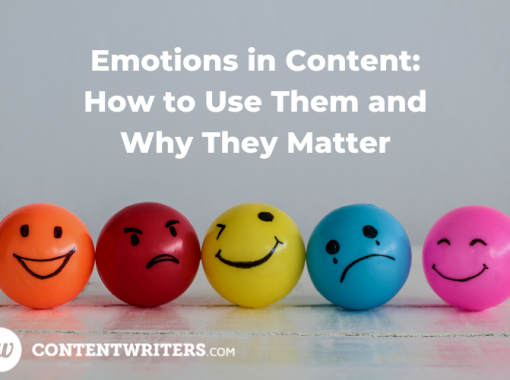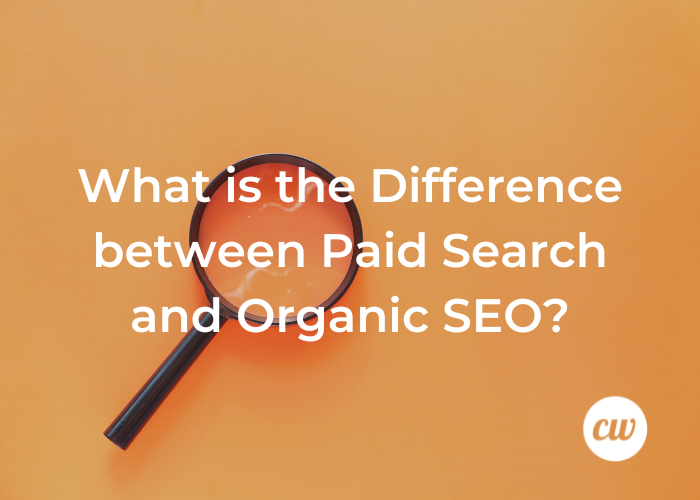
What is the Difference between Paid Search and Organic SEO?
Your business has a professional website with a clear call to action, but how do you get customers to visit? To drive web traffic through search marketing, you can choose between two major categories: paid search and organic SEO.
In this article, we’ll explain the difference between paid SEO and paid search, how to use paid search effectively, and organic SEO strategy for improving search engine results page (SERP) ranking.
The following FAQ’s will also be detailed throughout this article:
How do I create organic SEO?
Creating organic SEO requires developing high-quality content that provides useful information. It also requires on-page, off-page, and technical SEO strategies to ensure both site visitors and search engines see your content as valuable.
Why is SEO called organic?
SEO is called organic because it can deliver traffic to your website organically. In other words, without having to deploy paid advertising or paid search ads to generate traffic.
Is organic search engine optimization free?
Unlike paid search ads, organic search engine optimization does not incur a cost when someone clicks on your web page or landing page. However, there is an investment in time and money to create and manage the content you need.
Paid Search vs SEO
When comparing SEO and paid search, the first step is to define the terms.
What Is Paid Search?
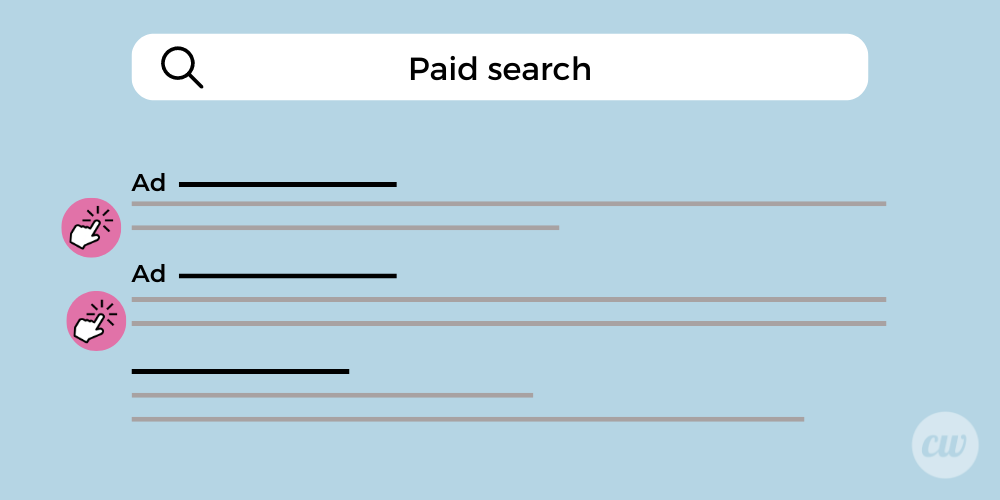
Paid Search is also called search engine marketing (SEM) and pay-per-click (PPC). It utilizes paid advertising on search engines like Google where marketers bid for top-performing keywords.
The biggest player in SEM is Google, which currently dominates the search market capturing more than 83 percent of search traffic. The next closet search engine is Microsoft’s Bing, which garners nearly 9% of search traffic.
As customers search online, paid search ads appear at the top of the results. Users click the link or click to call with their mobile phone.
Running a Google Ads campaign does not help your SEO rankings. However, paid search ads can be instrumental in expanding your reach and attracting quality leads online.
Google Ads (formerly known as Google AdWords) is the best-known SEM platform. There are others, including:
- Google Product Listing Ads
- Google Shopping Ads
- Microsoft Advertising (Includes Yahoo and Bing)
What Is Organic SEO?

Organic search engine optimization (SEO) includes both on-site SEO and off-site SEO. This kind of SEO content includes organic strategies like blog posts, web pages, and videos to appear in search results below paid ads. Off-site SEO includes link building and guest posts.
Consumers tend to trust organic results over paid advertising. They know the only way to win the top spots on the first page is through the quality of content.
How Google ranks your page against others is not a simple formula because the search engine has more than 200 ranking signals, but exactly what they are and how they work is a closely guarded secret. Google changes these ranking signals constantly. While major search algorithm updates may occur a few times a year, minor changes occur regularly, sometimes daily.
Recently, one of the biggest changes is a core update to focus on what Google calls helpful content. This update is designed to rank relevant, valuable content higher and reduce duplicate information. It is also designed to decrease content written primarily for search engines and not humans.
This puts a premium on high-quality, well-written content. Using an SEO content writing service with experienced writers can help craft content that provides the balance between valuable information and SEO best practices, such as leveraging keyword research.
Organic SEO also requires consistent attention. For example, if your page ranks for a while but most users who click don’t stay on your page, Google will assume the content on your web page is low-quality and replace your listing.
For this reason, quality and consistency are vital in your organic SEO strategy. Therefore, it’s essential to consistently publish content that engages your customers.
Which Works Better?
Which works better will depend on your goals. In most cases, marketers use a combination of paid search and organic SEO techniques.
- Paid search produces results faster but requires a consistent financial investment to maintain. As soon as you stop spending on SEO-paid search, the benefits stop. When people no longer see your paid ads at the top of search results pages, your web page traffic from those ads ends.
- SEO can take several months to produce organic traffic. However, once your web page ranks for a keyword, SEO generates traffic for months or years. Organic search engine optimization can put your web page near the top of search engine results pages, keeping your content front and center for people as they search.
Most digital marketing experts recommend using both paid search and organic SEO techniques– integrated and strategically aligned.
While at first glance, these techniques appear different, there are some things they have in common.
Four Things Paid Search and Organic SEO Have in Common
Paid search and organic SEO are both ways to connect with interested buyers when they are searching for your product or service.
1. Both Drive Traffic
Paid search and organic SEO are both designed to drive traffic to your website or landing page. They encompass some of the most significant ways your business can be visible on the web and build brand awareness as part of your digital marketing strategy, resulting in visits to your site.
2. Both Target Search Engine Rank
Both strategies aim to appear near the top of the search engine results page when shoppers or buyers search on Google for a specific keyword phrase.
3. Both Use Keywords
Both strategies require targeting keywords. Some keywords have steep competition between marketers. Experts recommend looking for keyword phrases that have a high volume of searches but low advertiser competition.
4. Both Improve with Customer Insight
A well-crafted headline and meta description need to align with your customer’s expectations. Companies can rank for keywords but lose conversions if customers want something different.
Results improve for both methods when you understand your audience and their needs. Digital marketing should reflect what customers are thinking while they search for products or services.
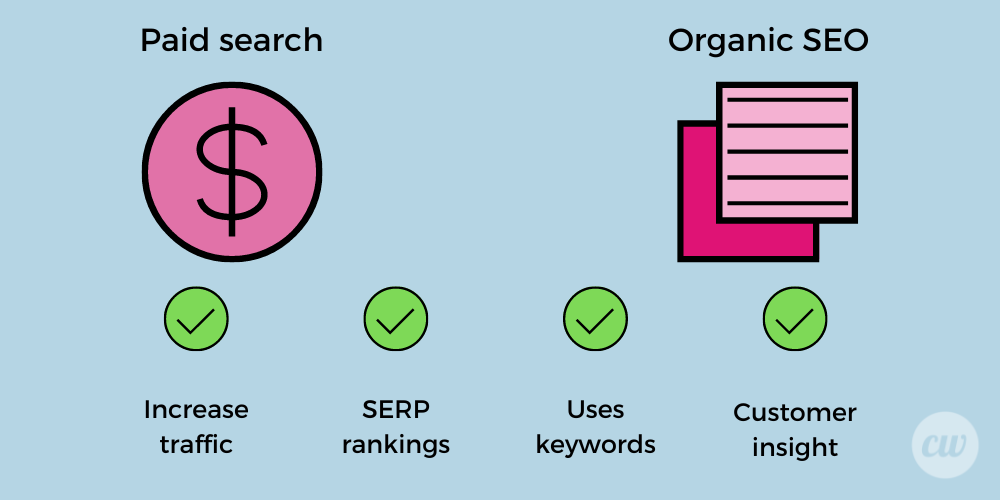
Five Ways Paid Search and Organic SEO are Different
While they both strive to improve search engine results and drive traffic to your site, paid search and organic SEO are different in several important ways.
1. Position on the Search Page
Paid search ads appear at the top of search results and include a tag letting users know it’s an ad. Organic results show lower on the page, below paid ads, and often below other content, such as featured snippets and map boxes featuring local businesses.
Organic search gets the most clicks, but paid ads get higher conversion levels. That makes sense if you think about it. Shoppers that are in the market right now are more susceptible to ads while others still in the consideration stage are more likely to be conducting research.
When your bids are high enough, paid search gets you to the top of the page. Organic search will take longer to get results but will have lasting power.
2. Cost
There’s a big difference in the cost per click (CPC):
- With SEM, you pay each time a user clicks on the paid search ad.
- With SEO, you pay to develop the content, but each customer’s click is free.
While both have a cost, organic search is less expensive in the long run because of this longevity. 61% of marketers say organic search engine optimization and SEO techniques such as content writing produce the best results for their inbound marketing.
Paid Search Costs
For paid search, position on the page is determined by how much you are willing to pay, the quality of your ads as determined by the search engine, and the competition for the space. Some competitive keywords can be extremely expensive.
Here are the top 10 most expensive keywords in 2022 according to WordStream’s keyword research:
- Insurance: $54.91
- Gas & Electricity: $54.62
- Mortgage: $47.12
- Attorney: $47.07
- Claim: $45.51
- Loans: $44.28
- Lawyer: $42.51
- Conference Call: $42.05
- Recovery: $42.03
- Donate: $42.02
As you can see, bidding on keywords for paid search ads is competitive and can get expensive quickly. If you are paying $40 or $50 every time someone clicks on your ads, it starts to add up. Search ads also have an average click-through rate of 4-6% and an average conversion rate of about 3.75%.
While we’ve highlighted some of the most expensive keywords, most keywords do not command such high prices. So, let’s say your keyword cost per click (CPC) is $10. Using these averages, let’s say 1,000 people see your paid search ad. That would result in about 50 people clicking on your ad, resulting in a cost of $500. Of those 50, you can expect an average of about 2.5 users to convert.
Organic Search Costs
While the traffic you get from organic search is free, there is a cost to produce and manage the content even in-house. You can outsource to an SEO writer, develop content yourself, or do both (as many organizations do).
Developing content for organic search takes time and expertise. It’s not enough just to publish quality content; you need to ensure the content is better than your competitor’s. Just like you can get outbid for paid search ad positions, better content will almost always rise to the top of the search results.
To do organic search well, you will need to invest in developing a content marketing strategy, including high-quality SEO writers, keyword research, and link building strategies.
3. Audience Targeting
Paid search allows you to target specific audiences. You can direct the search engine to show your ad only to people who live in a geographic area, express related interests, make a certain income, or fall within an age range. Google has 80 pre-built audience targeting options you can use, but you can also build a custom audience based on picking and choosing key attributes, behaviors, and affinities.
There is no audience targeting with organic SEO, although marketers use buyer personas and ideal customer profiles (ICPs) to develop content designed to target the right audience. This helps to frame content with specific users in mind and helps create more relevant content.
4. Time to Results
SEM provides rapid feedback and results. You can track your ad in analytics as soon as it’s launched and see how it’s performing at any time. You can also tweak ad copy, bids, and targeting at any time to test the impact.
Organic search will take longer to work, and it’s difficult to say how long exactly. Most marketing experts say you may see results in as little as two months, but it can take up to a year or longer to realize the impact. That’s because multiple variables impact the performance of your content in search engine results page rankings, including:
- Quality
- Competition
- Inbound links
- Page performance
The tighter your niche marketing, the easier it will be to rank. However, if you are in a crowded market that has lots of competition, it will take longer to break through. For example, if you are a dentist or chiropractor, your clients will come from within a small geographic area near your practice. This limits the number of competitors that will rank highly for content as search engines will give preference to local practices based on search intent.
However, if you are an eCommerce site that sells nationally or internationally, your business will be competing for organic search with every other site that sells similar products. There are more than 26 million eCommerce sites globally — 9.5 million in the US alone. Search for something like “custom-designed socks,” which is a niche product, and you’ll get more than 70 million results!
Here’s the good news about organic search though. Once you achieve a high ranking in Google, you can reap the benefits for a long time without the expense of paid search ads.
5. Longevity
Paid search results stop as soon as you turn off your ad and only run as long as you pay.
With a steady investment of robust, relevant content, SEO compounds over time. You can get leads from blogs you published months or years ago.
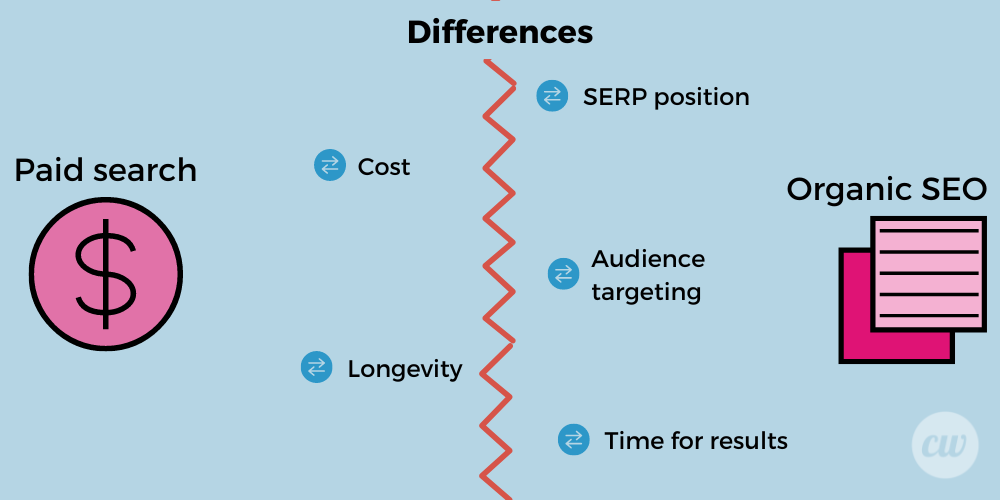
When to Use Paid Search Ads
Paid search helps you get visitors to your website today. Because it offers immediate feedback, SEM is a powerful tool for testing ad copy and landing page conversions. Optimizing your click-through and conversion rates can result in conversions.
Use paid search ads to:
- Attract website visitors quickly.
- Test ads, headlines, landing pages, conversion rates, and promotions.
- Explore markets or customer segments.
- Draw attention away from your competition.
- Achieve short-term sales goals.
When starting your first campaign on Google Ads, expect some trial and error, and don’t be afraid to experiment. Optimized with irresistible headlines and a compelling landing page, paid search can be cost-effective.
When to Use Organic Search Marketing
Organic search focuses on creating content and managing ranking signals to boost unpaid results in search pages. It is more effective than paid search in the long run as it doesn’t have immediate, recurring costs. However, even the best content will require regular maintenance of SEO strategies, including refreshing content and making sure information remains current.
Organic search has significant benefits, including:
- Organic search can help outrank competitors without having to pay for ads, providing a competitive advantage.
- It is cost-effective and scalable.
- Provides long-term results to optimize a brand’s visibility in search engines.
- Can be highly targeted to specific consumers.
If one of your company’s goals is to enhance your online presence for the long term, organic search marketing needs to be a key component of your digital marketing strategy.
Different Types of Organic SEO
Organic search engine optimization also incorporates three different strategies:
- On-Page SEO
- Off-Page SEO
- Technical SEO
Each plays an important role in helping to improve search engine rankings.
On-Page SEO
Search engines look at web pages differently than humans do. They look for key indicators to determine what a page is about and make quality assessments based on certain ranking signals.
On-page SEO, also known as on-site SEO, is designed to make sure the content you create will get noticed by search engines and be seen as valuable content that others would want to see. The best on-page SEO content will be:
- Authoritative and trustworthy
- Relevant, valuable information
- User-friendly in a format that is easy to read
- Unique
- Designed to meet search intent
To be effective, you must optimize your content for both search engines and people.
On-page SEO includes using the appropriate keywords without keyword stuffing. At the heart of on-page SEO is high-quality content. Without great content, none of the other strategies matter.
As a matter of fact, if you do everything else right but fail to deliver valuable insights when people click on your page, you could damage your brand.
Therefore, you always need to put creating quality content at the top of your organic SEO goals.
From there, content marketing strategies include:
- Using appropriate keywords within copy naturally
- Adding formatting and visual elements to break up the copy into easily digestible segments
- Targeting audiences with relevant content
- Solving problems and pain points and answering questions
- Developing content that others will want to share
- Optimizing for conversions, such as adding appropriate calls to action (CTAs)
These strategies help signal to site visitors and search engines that you are producing content that has merit.
One thing to avoid is simply replicating content that exists elsewhere because there are consequences for that kind of content. Duplicate content will be penalized by search engines and hurt your rankings.
What Is E-A-T and How Does It Affect SEO?
Another concept Google introduced recently is E-A-T as part of its quality rater guidelines.
E-A-T stands for:
- Expertise
- Authoritativeness
- Trustworthiness
Content needs to demonstrate each of these to better rank highly.
What Is YMYL and How Does It Affect SEO?
Google also introduced the idea of content that impacts people in important ways that it calls Your Money or Your Life (YMYL). According to Google, these are topics that “could significantly impact the health, financial stability, or safety of people, or the welfare or well-being of society.”
For example, the information needs to be accurate if someone is looking for tax advice or deadlines for filing their taxes. Another example, if someone is searching for the correct dosage for a type of medication, your content needs to provide correct information.
There’s a lot of misinformation online and search engines want to show trustworthy and accurate results.
Off-Page SEO
Off-page SEO, also known as off-site SEO, includes the actions taken outside of your website to help build search engine rankings and build a network of connections throughout the web. Off-site SEO is key to building a business’s online reputation. Showing up in multiple places across the web establishes your company as more reliable and reputable with search engines.
Backlinks
Anyone who publishes a link to your website is building your off-page SEO. A link from an external site that leads to your website is a backlink. For example, if a high-quality website includes a link to your site, search engines will see that you are a credible source. They are, in effect, providing an implied endorsement of your site in much the same way as a referral works from a trusted customer.
The most powerful type of off-page SEO is natural links. When others find your content and link to it naturally without any action on your part, it’s the best type of link you can get. Marketers also use tactics such as partnering with influencers and high-quality websites for link placements, such as endorsements or guest blogs.
You can also manually place links in online directories, forums, or issue press releases that can help build additional link profiles. However, you should stay away from companies that want to sell you links. Those kinds of links can impose a negative ranking signal from Google which will hurt your ranking.
Backlinks include links from blogs, local listings, news sites, and directory profiles. Regarding search engine rank, the most valuable backlinks are relevant to your content and published by reputable sites.
Other Off-Page SEO Strategies
Almost anything you do from your website to drive organic traffic will qualify as off-page SEO. This includes activities such as:
- Social media
- Influencer marketing
- Brand mentions
- Guest blogs
- Partnerships
Technical SEO
Technical SEO refers to the backend and foundational strategies that make your website function well and look great on any device. Technical SEO leads to higher search rankings by improving both the user and search crawler experience.
One example of technical SEO is page loading speeds. Even if you have great content, if your site is slow to load, Google will tend to feature sites that load fast. Search engines want to display the most relevant content that provides the best user experience. Slow-loading sites do not provide a high-quality user experience.
It’s also crucial that your website is mobile-friendly. The majority of traffic online now comes from mobile devices, so if your site isn’t built for mobile, it can also impact your rankings — especially when users are searching on a mobile device.
Other technical SEO strategies include best practices, such as:
- Website scheme markup and structured data
- Meta titles and meta descriptions
- Site security (HTTPS vs HTTP)
- XML sitemaps
- URL structure
In 2021, Google also launched Core Web Vitals, which goes even deeper into how websites perform and impact search results. Search results will be impacted by things that impact loading, interactivity, and visual stability.
Google calls these things:
- Largest Contentful Paint (LCP)
- First Input Delay (FID)
- Cumulative Layout Shift (CLS)
Largest Contentful Paint (LCP)
LCP measures loading speed by examining the amount of time it takes to load the most prominent content on your pages, such as the render time for hero images or videos.
First Input Delay (FID)
FID measures interactivity by evaluating how long it takes until users can interact with a page. This includes things like how long it takes between a button rendering on a page and a user’s ability to click on it, or how long it takes to click on a menu and have the page load.
Cumulative Layout Shift (CLS)
CLS looks for elements that load and cause web pages to shift around. Since elements often load at different speeds, Google is looking for a consistent display even as elements load.
Paid Search vs. Organic SEO: The Bottom Line
As you can see, there’s a significant difference between paid search and organic SEO. While paid search can lead to more immediate results, it also costs more and stops working the minute you decide to stop spending. Your costs are also impacted by your competitor’s actions and what they are willing to pay to outbid you.
Organic SEO takes longer to work but continues to work long into the future. Content marketing and deploying best practices to optimize your content and build authoritative, relevant, and helpful content can pay dividends for years to come.
If you’d like to explore different and better ways to create high-quality SEO content to improve your search engine rankings, we can help.
Editor’s note: This post was originally published in 2020 and has been completely updated for comprehensiveness and accuracy.
Paul is a multiple Emmy Award® winner with more than 20 years of experience as a journalist working for some of the country’s top publishers. For the past 10 years, Paul has worked as a marketing and advertising expert on projects for hundreds of clients.


